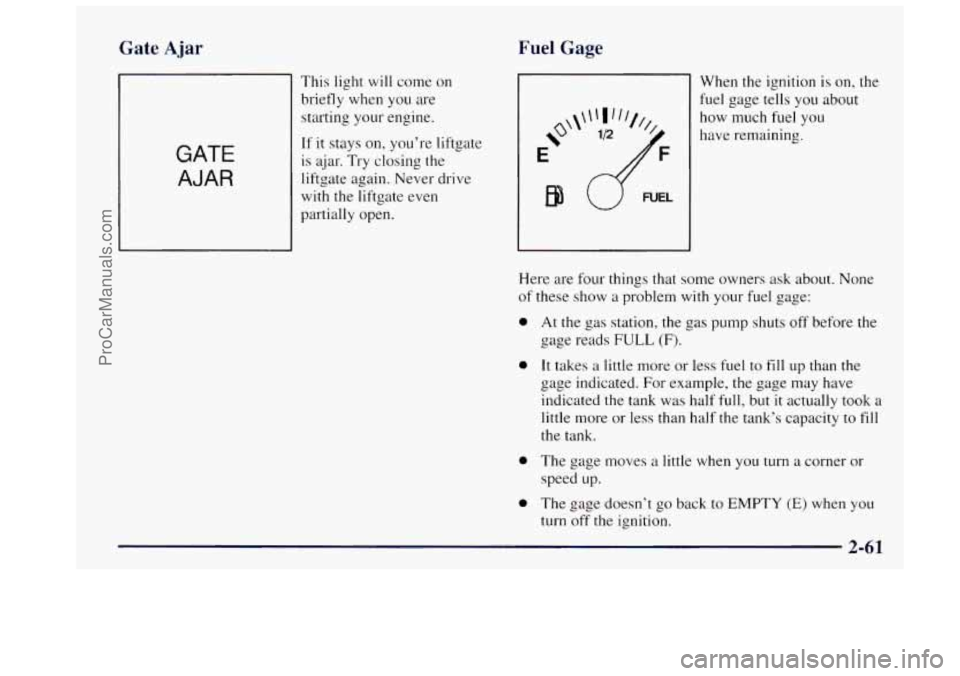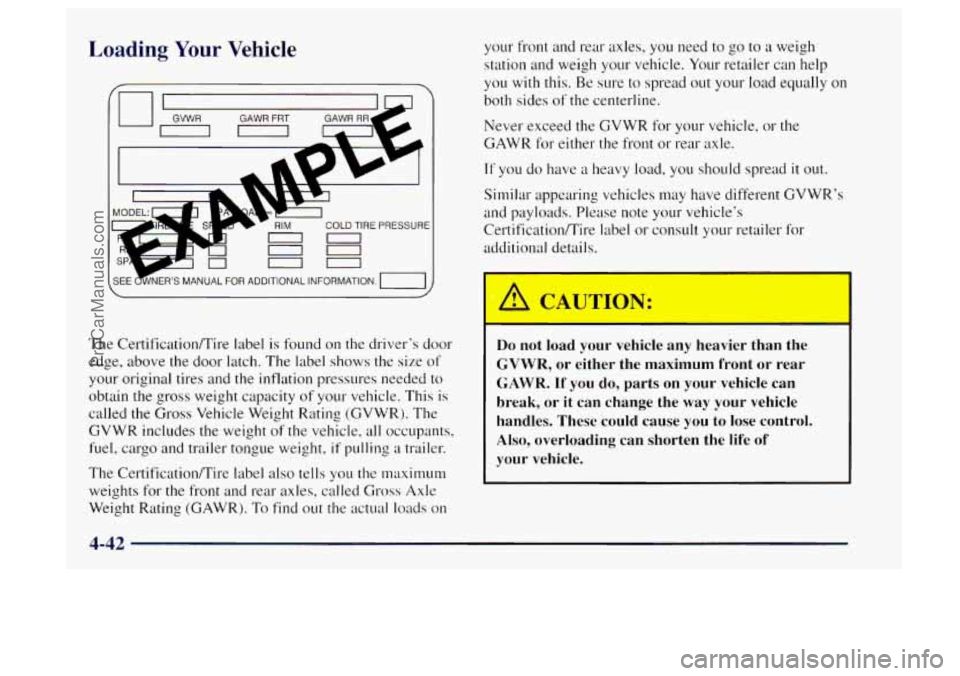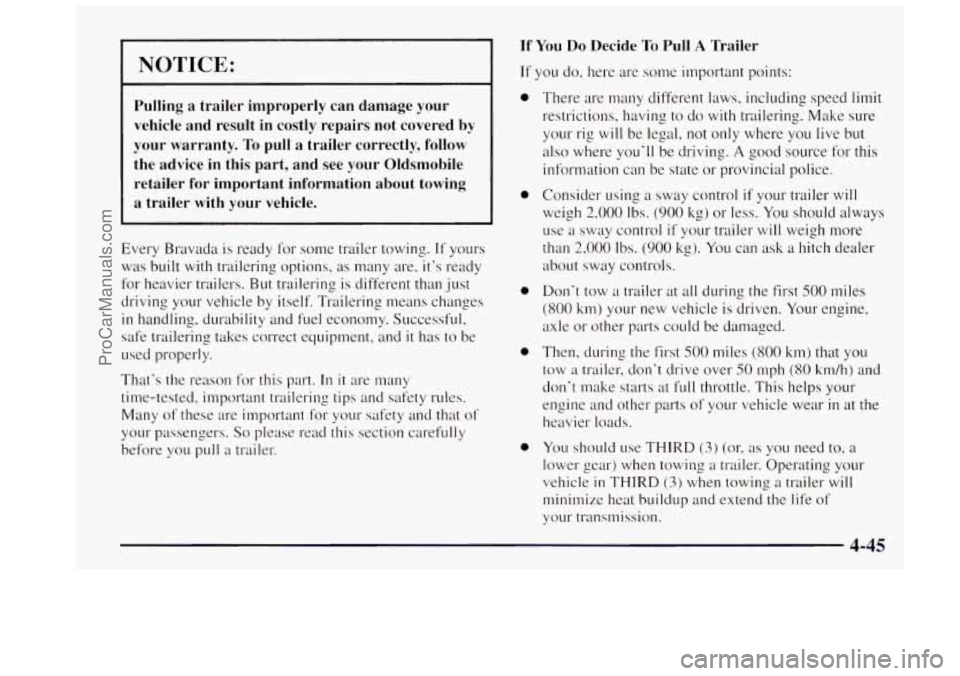1997 OLDSMOBILE BRAVADA fuel
[x] Cancel search: fuelPage 113 of 358

Have you recently changed brands of fuel‘?
If so, be sure to fuel your vehicle with quality fuel (see
“Fuel” in the Index). Poor fuel quality will cause your
engine not
to run as efficiently as designed. You may
notice this as stalling after start-up, stalling when you
put the vehicle into gear, misfiring, hesitation
on
acceleration or stumbling on acceleration. (These
conditions may go away once the engine is warmed up.)
This will
be detected by the system and cause the light
to turn on.
If you experience one or more of these conditions,
change the fuel brand you use.
It will require at least one
full tank of the proper fuel to turn the light off.
If none of the above steps have made the light turn off,
have your retailer or qualified service center check the
vehicle. Your retailer has
the proper test equipment and
diagnostic tools to fix any mechanical
or electrical
problems that may have developed.
Engine Oil Pressure Gage
OIL 0-
The oil pressure gage shows
the engine oil pressure
in
psi (pounds per square inch)
when the engine is running.
Oil pressure may vary with engine speed, outside
temperature and
oil viscosity, but readings above the
low pressure zone indicate the normal operating range.
2-59
ProCarManuals.com
Page 115 of 358

Fuel Gage
Gate Ajar
GATE
AJAR
This light will come on
briefly when you are
starting your engine.
If it stays on, you’re liftgate
is ajar.
Try closing the
liftgate again. Never drive
with the liftgate even
partially open.
i?‘
E
EB
When the ignition is on, the
fuel gage tells
you about
how much fuel you
have remaining.
Here are four things that some owners ask about. None
of these
show a problem with your fuel gage:
0
0
0
0
At the gas station, the gas pump shuts off before the
gage reads
FULL (F).
It takes a little more or less fuel to fill up than the
gage indicated. For example, the gage may have
indicated the tank was half full, but it actually took a
little more or less than half the tank’s capacity to fill
the tank.
The gage moves
a little when you turn a corner or
speed up.
The gage doesn’t
go back to EMPTY (E) when you
turn off the ignition.
ProCarManuals.com
Page 148 of 358

Before You Go Off-Roading
There are some things to do before you go out. For
example, be sure to have all necessary maintenance and
service work done. Check to make sure all underbody
shields (if
so equipped) are properly attached. Be sure
you read all the information about your
four-wheel-drive vehicle in this manual.
Is there enough
fuel?
Is the spare tire fully inflated? Are the fluid levels
up where they should be? What are the local laws that
apply to off-roading where you’ll be driving? If you
don’t know, you should check with law enforcement
people in the area. Will you be on someone’s private
land? If
so, be sure to get the necessary permission.
Loading Your Vehicle for Off-Road Driving
There are some important things to remember about
how to load your vehicle.
0 The heaviest things should be on the load floor and
forward of your rear axle. Put heavier items as far
forward as you can.
0 Be sure the load is secured properly, so driving on
the off-road terrain doesn’t toss things around.
0 Cargo on the load floor piled higher than
the seatbacks can be thrown forward
during
a sudden stop. You or your
passengers could be injured. Keep cargo
below the top of the seatbacks.
0 Unsecured cargo on the load floor can be
tossed about when driving over rough
terrain. You or your passengers can be
struck by flying objects. Secure the
cargo properly.
0 Heavy loads on the roof raise the vehicle’s
center of gravity, making
it more likely to
roll over. You can be seriously or fatally
injured if the vehicle rolls over. Put heavy
loads inside the cargo area, not on the roof.
Keep cargo in the cargo area
as far forward
and low
as possible.
You’ll find other important information in this manual.
See “Vehicle Loading,” “Luggage Carrier” and “Tires’’
in the Index.
ProCarManuals.com
Page 159 of 358

If the water isn’t too deep, then drive through it slowly. At
fast speeds, water splashes on your ignition system and
your vehicle can stall. Stalling can also occur
if you get
your tailpipe under water. And, as long
as your tailpipe is
under water, you‘ll never be able to stzt your engine.
When you go through water. remember that when your
brakes get wet,
it may take you longer to stop.
I
Driving through rushing water can be dangerous.
Deep water can sweep your vehicle downstream and you and your passengers could drown. If it’s
only shallow water, it can still wash away the
ground from under your tires, and you could lose
traction and roll the vehicle over. Don’t drive
through rushing water.
See “Driving Through Water‘. in the Index for more
information
on driving through water.
After Off-Road Driving
Remove any brush or debris that has collected on the
underbody, chassis or under the hood. These
accumulations can be a fire hazard.
After operation
in mud or sand, have the brake linings
cleaned and checked. These substances can cause
steering, suspension, wheels, tires and exhaust system
for damage. Also, check the fuel lines and cooling
system for any leakage.
2 (.lazing and uneven braking. Check the body structure,
Your vehicle will require more frequent service due to
off-road use. Refer to the Maintenance Schedule for
additional information.
4-27
ProCarManuals.com
Page 173 of 358

Know can trap exhaust gases under your vehicle.
This can cause deadly
CO (carbon monoxide) gas
to get inside. CO could overcome you and kill
you. You can’t see it or smell it,
so you might not
know it
is in your vehicle. Clear away snow from
around the base of your vehicle, especially any
that is blocking your exhaust pipe. And check
around again from time to time to be sure snow
doesn’t collect there.
Open a window just a little
on the side of the
vehicle that’s away from the wind. This will help
keep CO out.
Run your engine only as long as you must. This saves
fuel. When you
run the engine, make it go a little faster
than just idle. That is, push the accelerator slightly. This
uses less
fuel for the heat that you get and it keeps the
battery charged.
You will need a well-charged battery to
restart the vehicle, and possibly for signaling later on
with your headlamps. Let the heater run for awhile.
Then, shut the engine off and close the window almost
all the way to preserve the heat. Start the engine again
and repeat this only when you feel really uncomfortable
from the cold.
But do it as little as possible. Preserve the
fuel as long as you can. To help keep warm, you can get
out of the vehicle and do some fairly vigorous exercises
every half hour or
so until help comes.
4-41
ProCarManuals.com
Page 174 of 358

Loading Your Vehicle
The Certification/Tire label is found on the driver’s door
edge, above the door latch. The label shows the size of
your original tires and the inflation pressures needed to
obtain the gross weight capacity
of your vehicle. This is
called the
Gross Vehicle Weight Rating (GVWR). The
GVWR includes the weight
of the vehicle, all occupants,
fuel, cargo and trailer tongue weight,
if pulling a trailer.
The Certification/Tire label also tells you the maximum
weights
for the front and rear axles, called Gross Axle
Weight Rating (GAWR).
To find out the actual loads on your
front and rear axles, you need to
go to a weigh
station and weigh your vehicle.
Your retailer can help
you
with this. Be sure to spread out your load equally on
both sides
of the centerline.
Never exceed the GVWR for your vehicle,
or the
GAWR for either the front
or rear axle.
If you do have a heavy load, you should spread it out.
Similar appearing vehicles may have different GVWR’s
and payloads. Please note
your vehicle’s
Certificationflire label or consult your retailer
for
additional details.
Do not load your vehicle any heavier than the
GVWR, or either the maximum front or rear
GAWR. If you do, parts on your vehicle can
break, or it can change the
way your vehicle
handles. These could cause you to lose control.
Also, overloading can shorten the life of
your vehicle.
4-42
ProCarManuals.com
Page 177 of 358

I NOTICE:
Pulling a trailer improperly can damage your
vehicle and result in costly repairs not covered by
your warranty.
To pull a trailer correctly, follow
the advice in this part, and see your Oldsmobile
retailer for important information about towing
a trailer with
your vehicle.
Every Bravada is ready for some trailer towing. If yours
was built with trailering options, as many are, it’s ready
for heavier trailers. But trailering is different than just
driving
your vehicle by itself. Trailering means changes
in handling, durability and fuel economy. Successful,
safe trailering takes correct equipment, and
it has to be
used properly.
That’s the reason for this part.
In it are many
time-tested, important trailering tips and safety rules.
Many of these are important for your safety and that of
your passengers.
So please read this section carefully
before you pull
a trailer.
If You Do Decide To Pull A Trailer
If you do, here are some important points:
0
0
0
0
0
There are many different laws, including speed limit
restrictions, having to do with trailering. Make sure
your rig
will be legal, not only where you live but
also where you’ll be driving.
A good source for this
information can be state or provincial police.
Consider using a sway control
if your trailer will
weigh 2.000
Ibs. (900 kg) or less. You should always
use
a sway control if your trailer will weigh more
than 2,000 lbs. (900 kg). You can ask a hitch dealer
about sway controls.
Don’t tow a trailer at all during the first 500 miles
(800 kln) your new vehicle
is driven. Your engine,
axle or other parts could be damaged.
Then, during the first 500 miles (800
kin) that you
tow a trailer, don’t drive over SO mph (80 kdh) and
don‘t make starts at
full throttle. This helps your
engine and other parts of your vehicle wear
in at the
heavier loads.
You should use THIRD
(3) (or, as you need to, a
lower gear) when towing a trailer. Operating your
vehicle
in THIRD (3) when towing a trailer will
minimize heat buildup and extend the life of
your transmission.
4-45
ProCarManuals.com
Page 221 of 358

Section 6 Service and Appearance Care
Here you will find information about the care of your Oldsmobile. This section begins with service and fuel
information, and then it shows how to check important fluid and lubricant levels. There is also technical information
about
your vehicle, and a part devoted to its appearance care.
6-
2
6- 3
6-4
6-5
6-6
6-9
6- 14
6-20
6- 24
6-25
6-29
6-29
6-30
6-34
6-37 Doing
Your Own Service Work
What Kind of Fuel to Use
Using Fuel
in Foreign Countries
Where to Put the Fuel and Filling
the Tank
Checking Things Under the Hood
Checking Your Engine Oil
Automatic Transmission Fluid
Engine Coolant
Where to Fill
the Windshield Washer Fluid
Important Brake Information
Information
on Your Vehicle’s Battery
Tips
on Vehicle Storage
Bulb Replacement Procedures
Windshield Wiper Blade Replacement How and When
to Check Tire Inflation 6-39
6-42
6-44
6-47
6-48
6-50
6-5
1
6-52
6-53
6-54
6-55 6-59
6-60
6-60
6-6
I
When it is Time to Buy New Tires
Wheel Alignment
Cleaning the Inside
of Your Oldsmobile
Care
of the Safety Belts
Cleaning the Outside
of Your Oldsmobile
How to Clean Aluminum Wheels
Underbody Maintenance
Recommended Appearance Care Materials
Your Vehicle Identification Number
(VIN)
The Electrical System
Fuses and Circuit Breakers
Replacement Bulb Types for Your Vehicle
Capacities and Specifications
Normal Replacement Parts
Air Conditioning Specifications
6-1
- -~ -
ProCarManuals.com